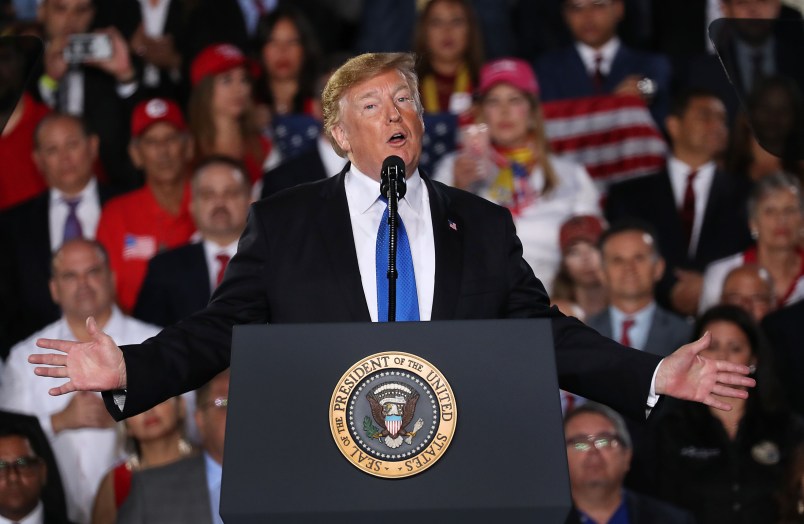WASHINGTON (AP) — Frustrated by a divided Congress and rifts within his own party, President Donald Trump is giving little indication in his latest budget proposal of any new policy ambitions for the coming two, or six, years.
Trump’s budget plan increases spending on his border wall and the military but is light on fresh ideas heading into his re-election campaign. His budget for the next fiscal year, which has little chance of advancing in Congress, largely focuses on deep spending cuts and pushing more money toward established goals such as his long-promised wall, improving care of veterans and combating opioid abuse.
Budgets may offer a president’s vision for the direction of the nation, but Trump’s latest also offers an early window into his upcoming campaign.
With the Democratic race to unseat him heating up, Trump is contending with middling approval ratings, energized Democrats and political vulnerabilities in critical states. Like his predecessors, he’ll soon be called on to complete the politically loaded phrase, “Send me back to the White House so that I can …”
“I think, as he gets closer to 2020, he will need to lay out what a second term would look like,” said Republican consultant Alex Conant. “Voters always want to know, ‘What have you done for me lately?’ If he doesn’t paint a picture of what his second term will look like, then the Democrats will do it for him.”
The White House argues that Trump isn’t just advancing the same policies a second time over, he’s enhancing them with more detail than his first go-round, particularly in the area of trade policy.
Following a State of the Union address that contained little new policy, the budget is hardly a surprise. Still, the budget can serve more than one political purpose, argued former Trump campaign aide Barry Bennett, who said the document highlights Trump’s clashes with Democrats over border and military funding. He argued that the Democratic tilt to the left also will benefit Trump as he seeks to frame the argument.
Bennett said Trump’s pitch can be: “If your paycheck likes what I’ve done, send me back. If you don’t, they’ll undo it all.”
Trump has already addressed much of his laundry-list agenda from 2016, notching victories in many areas while seeking to minimize losses and mixed results. He has cut taxes, exited global accords and installed conservative judges on the courts, including two Supreme Court justices. He has not succeeded in replacing President Barack Obama’s health care law, is still working on renegotiating trade deals and has struggled to secure all the funding he wants for his border wall.
In all, the efforts have largely pleased his political base, but satisfaction with past performance is hardly a reliable tactic for expanding your support.
Thus far, Trump’s re-election campaign moves have been laser-focused on maintaining his most ardent supporters. It’s a risky wager, laid down by the president himself, that he can overcome weakness with moderate and independent voters by turning out even more loyalists in 2020 than he did in 2016.
During his aggressive push to maintain the GOP’s hold over the Senate during the midterm elections, Trump emphasized his hardline immigration rhetoric above all else. He has returned again and again to his long-promised border wall, even forcing the government to partially shut down in an effort to win funding. The latest budget also calls for repealing “Obamacare,” limiting future federal spending on Medicaid for people with lower incomes, as well as breaking out the new Space Force as its own military branch.
“We believe that every budget is an opportunity to put forward our vision for the next 10 years,” said acting budget director Russell Vought.
Trump’s gamble has skeptics among some in the president’s inner circle, who have pushed the president and the White House to embrace larger policy ideas designed to win over moderates and independents.
Aides point to Trump’s cautious embrace of a family medical leave policy pushed by his daughter, Ivanka Trump, as the sort of proposal Trump’s team should spend more time developing ahead of 2020. She is backing new funding for child care in the current proposal. A White House-backed infrastructure plan, the hobbyhorse of Washington election year policy, appears no closer to fruition than when Trump first raised it two years ago, with his budget allocation unchanged from previous years.
Trump’s nascent re-election campaign has just begun staffing-up for 2020, with a focus on developing a more professionalized operation than 2016, but has yet to announce a policy staff.
Trump’s light policy load is also a function of his increasingly strained relationship with Congress. Under divided control, the White House views it as unlikely that any new proposals can win legislative approval — and plan to be judicious about sending anything to Capitol Hill only to see it defeated.



